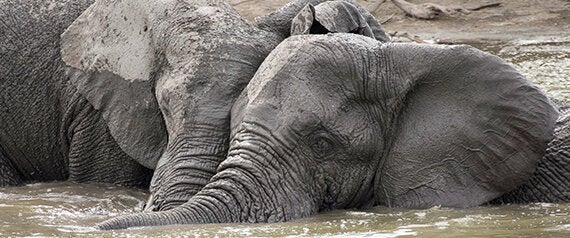
©Heike Pander
Two different brothers share an extraordinary passion for baobabs and elephants. Both were born in southern Africa - Ralph Stutchbury, photographer and filmmaker, in Zambia in the 1950s and Wayne Stutchbury, artist, in Zimbabwe in the 1960s.
Father Jeff worked as a gamekeeper in Zambia. Later he run various safari camps together with his wife Veronica. At last, the family lived at Chikwenya on the banks of the Zambezi River near Mana Pools, the world famous National Park and UNESCO World Heritage Site in northern Zimbabwe.

Ralph Stutchbury in front of a baobab
Committed to a Simple Life in Nature
The brothers grew up close to nature. The father designed and built their accommodation himself. From an early age the children got used to a basic lifestyle with wood stoves, latrines and kerosene lamps. Early on they learned respect for nature and wildlife and how to move around in animal habitats without disturbing them.

Elephants at Gonarezhou National Park, Zimbabwe
Both developed their artistic side. The more technology oriented perfectionist Ralph became a well-known photographer, award-winning filmmaker, conservationist and author. "I have inherited my interest for photography from my father. He always carried a camera with him when he took out guests for tours or went out on his own."
The World Through a Camera Viewfinder
After school, which he partly spent in boarding school in South Africa, he went for training as a journalist and finally graduated as a news cameraman - at a time when Zimbabwe slowly grew into its new role as an independent country. At that time he "had a real sense of witnessing history unfolding through my lens."
He launched his own company "Eyes and Ears" in 1980. At that time he earned his money by producing commercials and worked with well-known local artists like Simon Shumba, Oliver Mtukudzi and others. As a cameraman he was part of filming teams in movies.
At Victoria Falls, he filmed a sequence of "Sherlock Holmes" with Christopher Lee, Patrick McNee and Jenny Seagrove. As he recalls those memories he says, "it was very exciting to see how scenes developed".
At the end of the civil war in Mozambique, he filmed a music video for Eric Clapton and was part of Paul Simon's film "Graceland". He states that this was "the peak of my career as a cameraman".
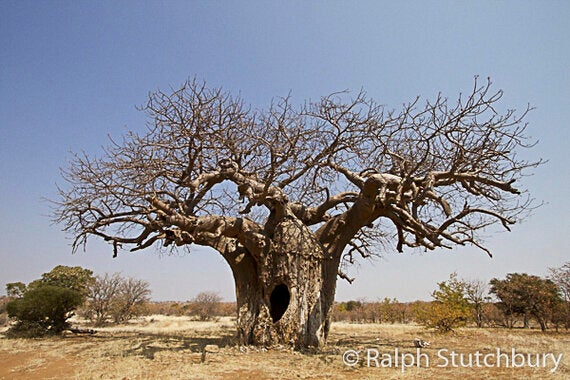
Baobab with hole, Zimbabwe
A Heart for Documentary
Apart from his career in the film and advertising business he became well known as a documentary filmmaker. With his knowledge of animal "hot spots" in southern Africa and his skills as a cameraman, he made it into programs of Discovery Channel, BBC and National Geographic with his animal documentaries.
He filmed everything from "oxpecker re-introductions to a leopard being fitted with a new gold canine tooth", the cameraman adds still excited. A few years ago, he announced in an interview with "Out of Africa": "I am determined to make interesting documentary films about Baobabs and Elephants". Meanwhile he has realized his vision.
Beauty in Places Hard to Reach
The Filmmaker has visited baobabs at remote but nevertheless magical places like Lekhubu Island in Botswana or Epupa Falls in Namibia. He has filmed at difficult to reach places, such as Mana Pools and Gonarezhou in Zimbabwe.

Chilojo Cliffs, Gonarezhou, Zimbabwe
In his documentary he skillfully describes the ecosystem of Baobabs in words and pictures. Little stories and myths are interwoven with geographical information and biological facts. His work is based on thorough research compiled in numerous conversations with baobab users and experts. The resulting film covers everything one could wish to know about the giants.
A Masterpiece of its Genre
Meanwhile, the documentary is ready and waits to be broadcasted. But it seems to be more difficult for documentaries to make it into mainstream television these days. Which has nothing to do with the quality of this specific documentary material.
The filmmaker knows his craft and the African bush with its magnificent baobabs like no other. But, as he says a bit wearily "no one is threatened or killed in my film and there are no beautiful women showing their beaming smile." People call for more "action": a shark killing a seal in a spectacular leap, a crocodile wrestling down a wildebeest or a lion ripping apart an antelope. The peaceful Baobab cannot put up with that sensation.
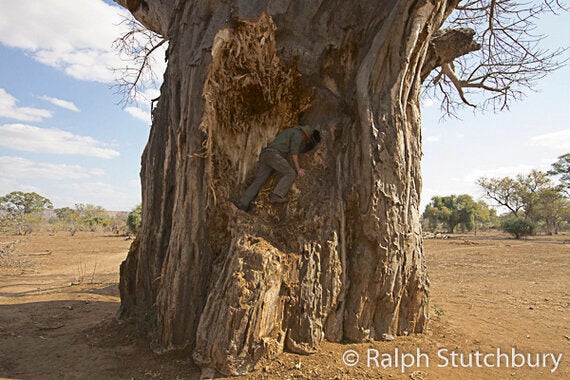
Baobab with hole, Zimbabwe
Perhaps times are changing soon, because health-conscious consumers all over the world are discovering baobab fruit as a new "Super Fruit". Traditional medicine in Africa has used it for its healthy ingredients for hundreds of years.
While trying to find a broadcaster for his documentary, the pragmatic has meanwhile published two coffee-table books: one about baobabs and another about elephants. When he is out in the bush filming, he always carries a stills camera - like his father. He took hundreds of photographs of baobabs and elephants.
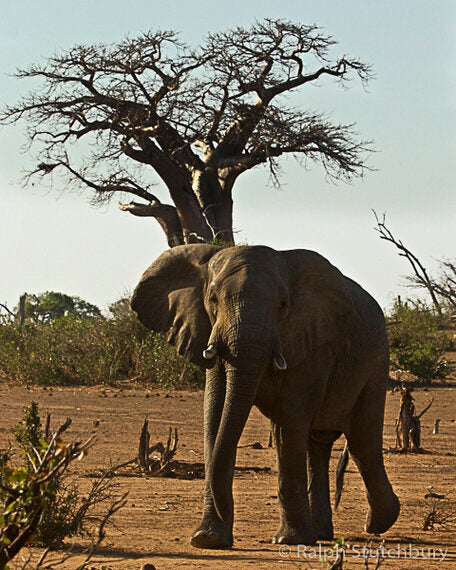
Baobab and Elephant
"The more I learn about baobabs, the more fascinating they become", he says and talks about writing another book about the giants. Ever since the coffee-table book has arrived on the market his readers provide him with new information about where to find interesting trees.
Brother Wayne is into Colors and Shapes
Wayne however is completely immersed in his world of colors and shapes. He lives and works as a painter and sculptor in Harare. Like his brother Ralph he was influenced and shaped by living in the "bush". Baobabs and elephants inspired him very early in life.
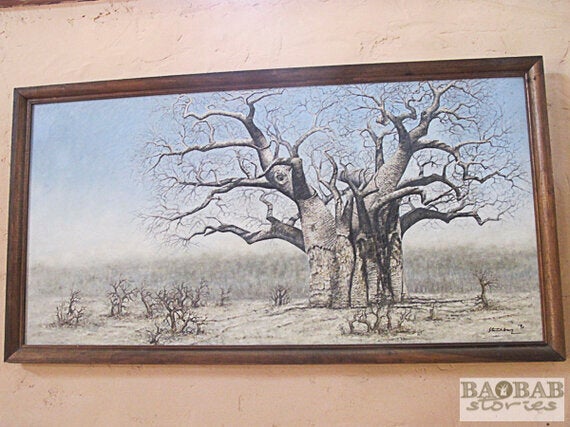
Baobab, Painting by Wayne Stutchbury
Wayne likes to study his motives in the wild. As in earlier days he is drawn into magical Mana Pools. The National Park is one of a few without fences and solid structures - except for the administration building. Those spending some nights there do so in their own tent, a vehicle or in luxurious safari camps.
Wayne enjoys the tranquility of that place - high above on the escarpment, far from the touristy bustle at the legendary Zambezi River slowly flowing through Mana Pools.
Chitaki, the plateau, is known for its picturesque collection of baobabs.

Baobabs at Chitaki, Painting by Wayne Stutchbury
Chitaki - a Place with a Long History
People settled at Chitaki probably as far back as the 15th century. Traders used the "Gold Trail" leading through the area for their business. The structures of the old settlements have long since disappeared. Nevertheless, remnants of old clay pots or flints can still be found around the ancient baobabs.
At this spot "one can see for miles and is instantly drawn there - to the giant trees and how they relate to each other. If it was ever people here this is where they would stay", says the artist. Wayne appreciates the place because of its silence, the mystical aura and its mesmerizing views.
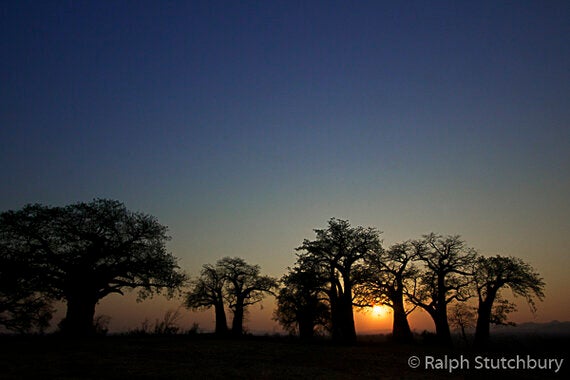
Sunrise at Chitaki, Zimbabwe
His favorite time of the year to study and draw baobabs is around July and August because "everything is a little brown" in Zimbabwean winter. According to him, leaves hinder the clear view of the tree structure while drawing. With leaves a baobab is "just this big bulb" which does not allow to get a good impression of the shape.
A Dangerous Adventure
Wayne recalls a memorable expedition several years ago. At that time he packed his old Land Rover with food and all the other necessities for a two-week camping trip to Chitaki. There, he concentrated on his baobab studies because "there is nothing else to do there", he adds.
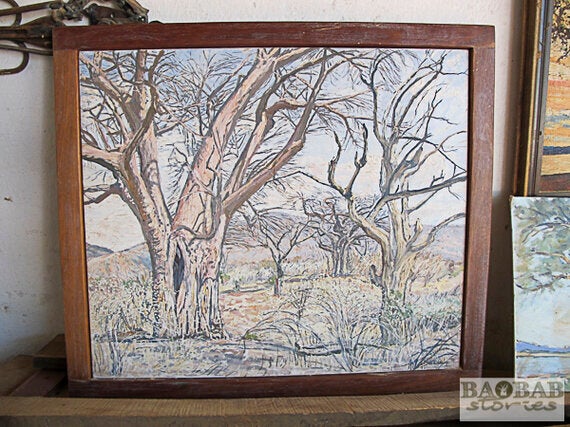
Baobabs at Chitaki, Painting by Wayne Stutchbury
Wandering around alone is not advisable. Lion and other predators live in the valley and there is nobody to come and help in any case of emergency.
After one and a half weeks Wayne ran out of water. At noon, when the sun beats down mercilessly from the sky, he took his canisters, a towel and some soap and went down to the river.
During that time of the year the dry season diminishes water supplies and the wild animals rely on this river for its year-round water supply. "Easy prey" for lion - all they have to do is sit and wait.
Wayne took off his clothes and plunged into the water. "I was frolicking, jumping around, being a fool and enjoying the refreshing water", he recalls. After his bath he got dressed, gathered his belongings and looked up at the water's edge.
"I noticed that they were just right there - you know how they line up. You know how still they are." Since it was midday the big cats were rather sleepy and not interested in a hunt. "But there - nine lion were watching my display of frivolity. And in a horror I reversed out of there".
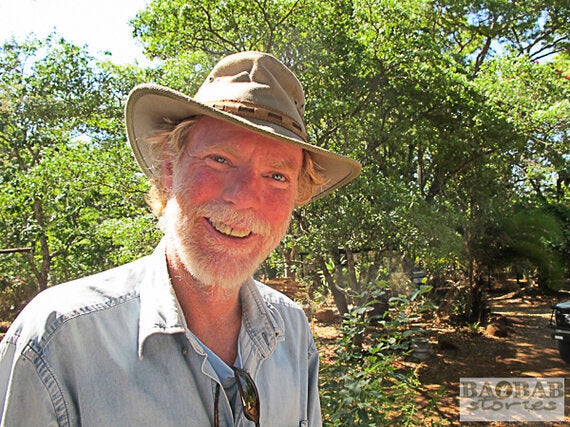
Wayne Stutchbury
Being Strong in the Wind
He relates his passion for baobabs to their appearance: "I am a sculptor and I just love their shape. They are amazing. If you look at them the skin reflects the light. In the mornings colours seem richer compared to late afternoon. Baobabs are not just a normal tree - they reflect the blue and purple of the sky. For an artist, that is great."
Although he mainly works as a sculptor, Wayne has not done an interpretation of baobabs in his sculptural work. So far, he has preferred to paint the trees. But he has observed another sculptor at work in Chitaki: the wind. An as he describes it: "You see these huge things bend and then they howl in the breeze - it is quite surreal and even spooky when that wind comes up at night."
According to the artist, the strong Chitaki wind is prevailing and as consistent as the sunrise every morning - almost always blowing in that same direction. "You look at those trees and see where the wind comes from - the shape was formed by the wind." The trees adapt and grow into the protected direction.
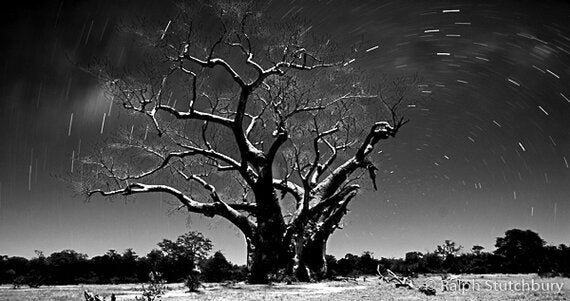
Nightsky, Chikwenya, Zimbabwe
A Completely Different Use
A very old Baobab grows in Chikwenya. Wayne knows a very specific story to tell about that tree. It features a large hole in its bark and the inside of the tree is hollow - that is quite common with old baobabs. He could not withstand his curiosity and climbed into the tree.
Inside he saw wooden pegs in the walls reaching way up to the hollow branches. On the floor lay pots and other gifts known from traditional burial sites in Zimbabwe.
One of the huge branches was sealed with clay. Wayne found out that relatives had buried the sister of a former Chikwenya chief in the hollow branch. He had entered a mausoleum. Ralph remembers the same Baobab, too. He found himself in the mausoleum while filming bats for his baobab documentary.
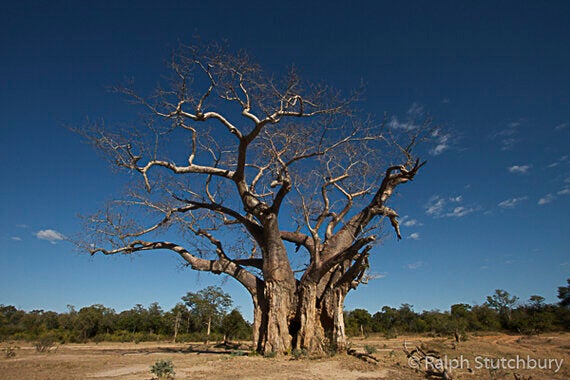
Stutchbury Family Tree, Chikwenya, Zimbabwe
They share another baobab story - when the Stutchbury brothers were young a huge baobab grew at their camp in Chikwenya. With every trip to and from the house they had to pass the tree. To the family and interestingly enough to the employees of the father the baobab was known as the "Stutchbury's family tree".
Baobabs and Elephants - a Contagious Inspiration
Some years ago the brothers used to work together. While Ralph did his filming, Wayne assisted him with working the technical equipment. During break time, however, he drew and painted baobabs and elephants. No wonder that at some point he passed on his enthusiasm to his brother Ralph. In addition, the latter received a beautiful painting with baobabs from Chitaki for his 40th birthday from his brother - which contributed to his deep connection to the trees.
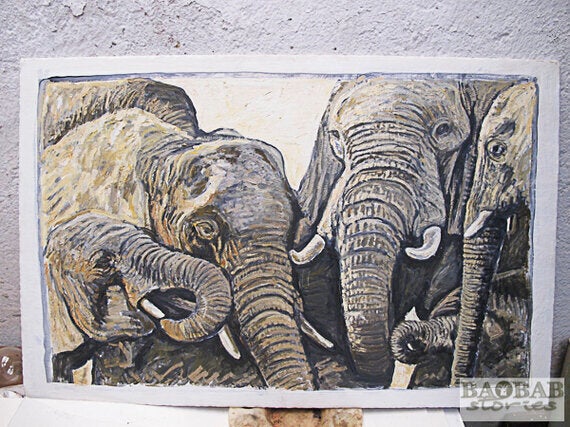
Elephants, Painting by Wayne Stutchbury
Elephants and baobabs are "the largest living mammals and the largest living trees on the African continent" - that, so Ralph, is enough reason for his fascination. He closes by saying "you cannot just walk past a baobab, without noticing it."
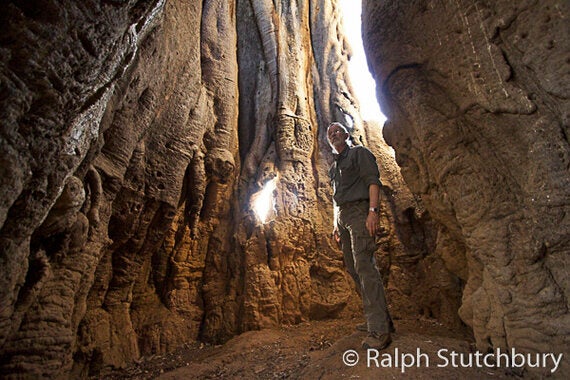
Ralph Stutchbury in a hollow baobab
More:
www.baobabstories.com/en/
www.waynestutchbury.com/
www.ralphstutchbury.com/
